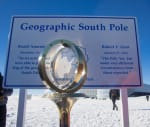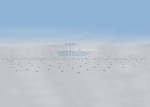The IceCube Neutrino Observatory team is anxiously awaiting the arrival of Armando Caussade at the South Pole. Caussade’s long journey from Puerto Rico to the frozen, windy desert that he will call home for a couple of weeks started on January 2, 2015. Although he arrived as scheduled at McMurdo Station on the coast of Antarctica on January 5, 2015, the last leg of his journey to the South Pole has been delayed two days so far due to poor weather. […]
News
Week 52 at the Pole
Although you might expect that it would remain fixed, the marker at the geographic South Pole is moved on a regular basis. Since the polar ice sheet is constantly shifting, at about 10 meters per year, the marker at the South Pole must be relocated to maintain its position. A new marker is crafted each year and inaugurated in a special ceremony on January 1st. […]
Week 51 at the Pole
The year wrapped up nicely at the South Pole, with the traditional holiday dinner and the Race Around the World on Christmas morning. Both of IceCube’s winterovers participated in the run. Other winterovers were busy constructing a handsome gingerbread house for seasonal charm. […]
Gamma-ray bursts are not main contributors to the astrophysical neutrino flux in IceCube
Gamma-ray bursts (GRBs) were once the most promising candidate source of ultra-high-energy cosmic rays (UHECRs). They release extremely large amounts of energy in short periods of time, so if they could accelerate protons as they do electrons, then GRBs could account for most of the observed UHECRs. […]
Week 49 at the Pole
Summer upgrades to the SPS (South Pole System), part of IceCube’s computing infrastructure, were completed this week, and two IceCubers who had been working at the Pole, Ralf and James, left for warmer climes. […]
Designing the future of the IceCube Neutrino Observatory
Prof. Olga Botner, IceCube spokesperson and a physics professor at the University of Uppsala, and Prof. Francis Halzen, IceCube principal investigator and a professor at the University of Wisconsin–Madison, tell us about the plans for an upgrade to the IceCube Neutrino Observatory. As an extension of the current detector, it can be built in a few years and within an affordable budget, thanks to expertise acquired with IceCube. […]
Week 48 at the Pole
Indoor tasks can be done just about any time, but for outdoor activities you need some cooperation from the weather. A bright sunny day makes things better still. Even with a few bouts of bad weather that caused postponements, there was plenty of outdoor work accomplished this week. […]
Drilling IceCube: a story of innovation, expertise and strong will
Building a cubic-kilometer telescope at the South Pole seemed a chimera even for some of those involved in the project. The goal was simple in words but seemingly impossible in practice: 86 boreholes, each 60 cm in diameter and 2,500 m deep, had to be drilled and instrumented in seven austral summer seasons. Safety was a must, fuel needed to be used cautiously and the South Pole environment was just unavoidable. […]
2015 IceCube Masterclass registration now open
Registration for the 2015 IceCube Masterclass, to take place on March 18th at ten IceCube hosting institutions, is open to high school students in their last two years before college. […]
Week 47 at the Pole
Just in time for Thanksgiving dinner, the South Pole traverse arrived, bringing fuel that would otherwise have had to come by plane. IceCube winterover Stefan skied out to check it out […]









